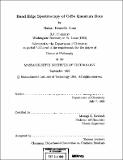Band edge spectroscopy of CdSe quantum dots
Author(s)
Kuno, Masaru Kenneth, 1971-
DownloadFull printable version (20.68Mb)
Advisor
Moungi B. Bawendi.
Terms of use
Metadata
Show full item recordAbstract
In this thesis, I describe work done to understand the band edge exciton fine structure of CdSe quantum dots (QDs). These QDs or nanocrystallites are the result of recent synthetic efforts in the Bawendi group to produce nearly monodisperse nanocrystalline materials. The QDs are roughly spherical in shape and range in size from 10 to 50 A in radius. A number of optical experiments have been conducted on the material to understand its optical properties, particularly, the absorption and luminescence. However, several longstanding questions remain. Among them is the origin of the material's band edge luminescence. The emission is unusual because it displays long ([mu]s) lifetimes and exhibits a characteristic, size dependent, Stokes shift. As a consequence, many past studies have implicated the surface as the origin of the emission. In this respect, the surface localization of photogenerated carriers qualitatively explains both the long lifetimes and redshift of the luminescence. Recent theoretical and experimental studies, however, have suggested that the emission arises from an intrinsic core state analogous to a triplet state in small molecules. We describe the theoretical modeling of the QD electronic structure in.eluding the effects of shape, crystal field and the electron-hole exchange interaction. When all symmetry breaking effects are considered, we predict the presence of five fine structure states underlying the hand edge exciton rather than an eightfold degenerate exciton ground state. Following this, we intentionally modify the surface of the nanocrystallites to see the effect this has on the luminescence. Our results suggest that, to a large extent, the surface plays little role in the energetics of the emission. For QDs passivated with different organic and inorganic ligands we find little or no change in values of the "resonant" and "non-resonant" Stokes shift. This strongly supports the above mentioned fine structure model. Subsequent chapters take the proposed theory a step further, using it to explain the unusual behavior of the nanocrystallites subjected to an external magnetic field. The last two chapters pose the question of what happens when the QDs are intentionally doped with a paramagnetic impurity such as manganese? We expected that spin interactions between host and dopant will result in interesting optical phenomena such as the activation of dark excitons as well as shifts in fine structure energies due to an exchange induced mixing of states.
Description
Thesis (Ph.D.)--Massachusetts Institute of Technology, Dept. of Chemistry, 1998. Includes bibliographical references (p. 373-381) and index.
Date issued
1998Department
Massachusetts Institute of Technology. Department of ChemistryPublisher
Massachusetts Institute of Technology
Keywords
Chemistry